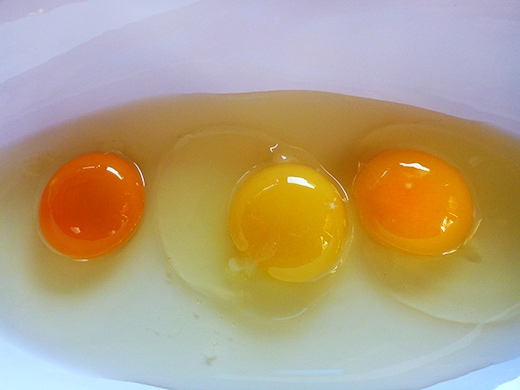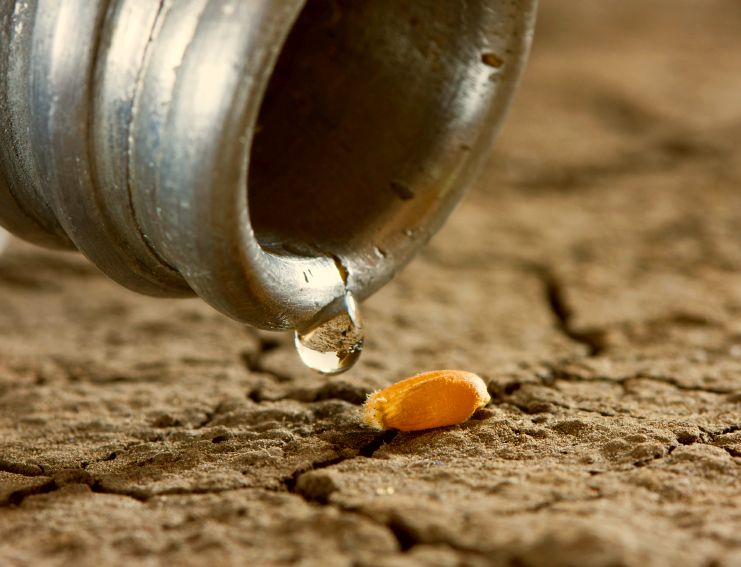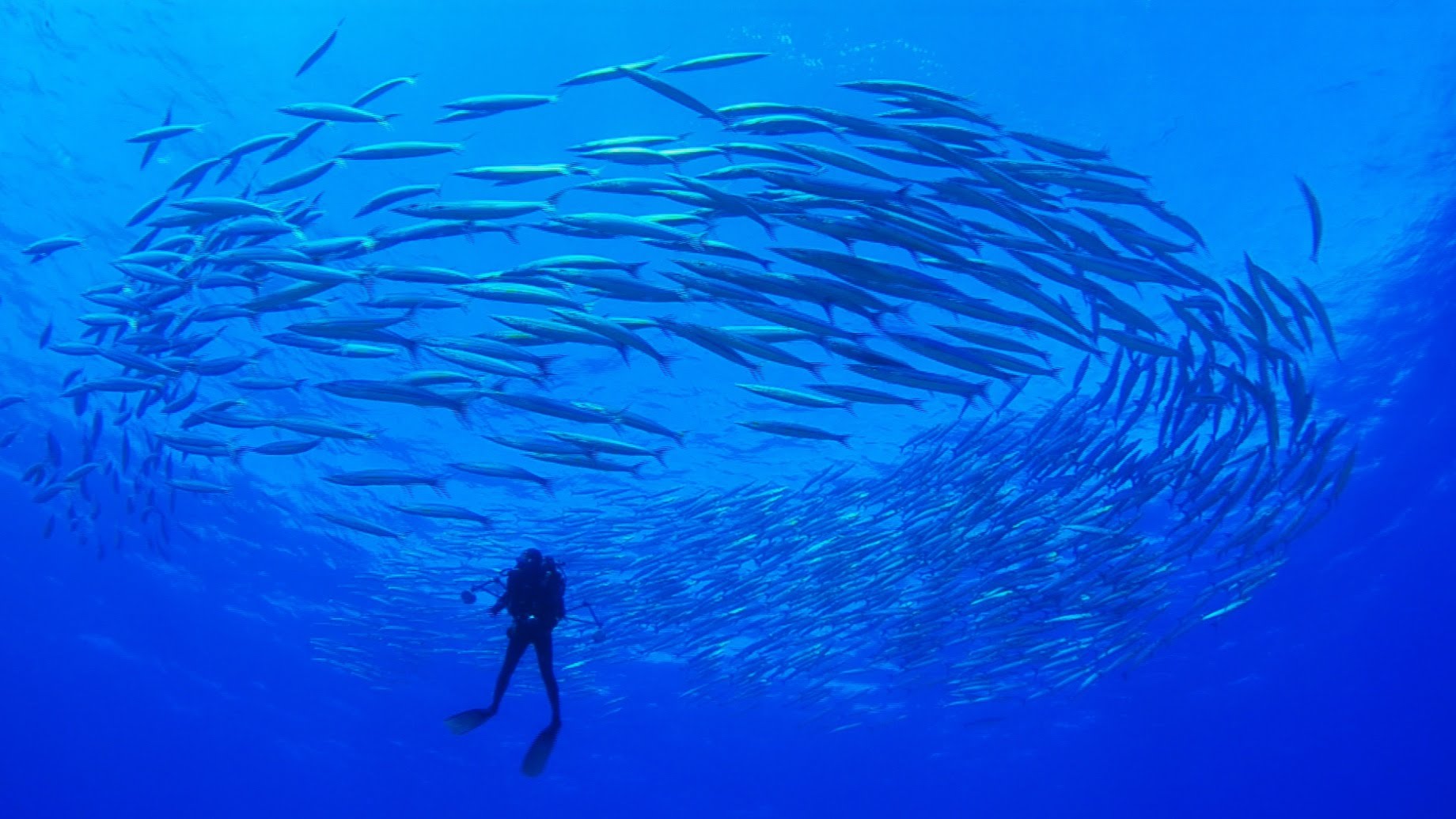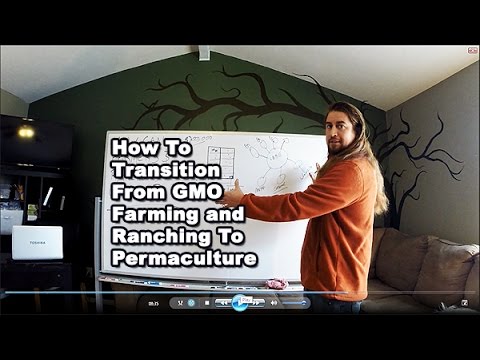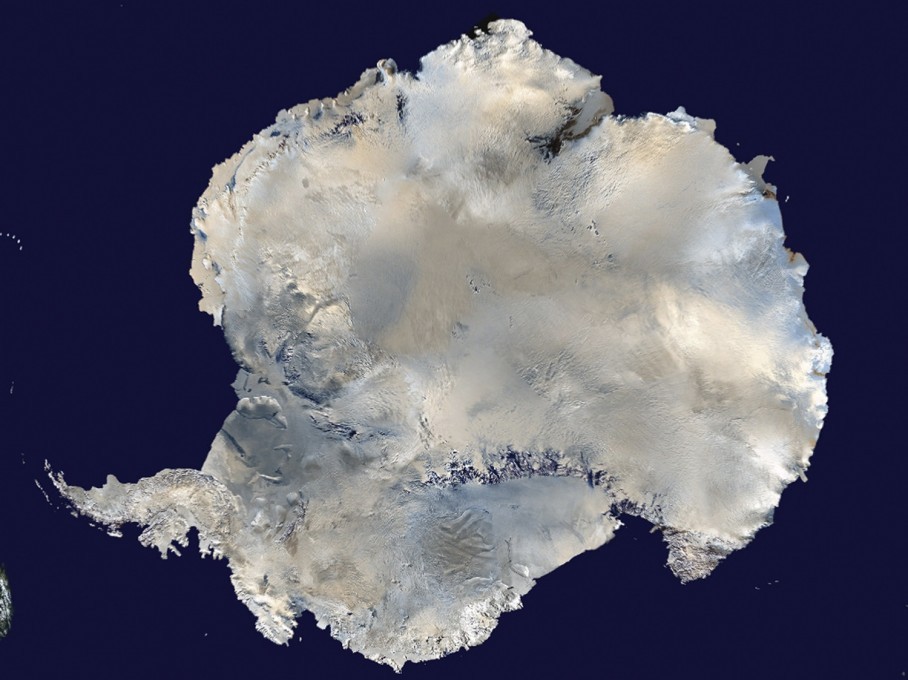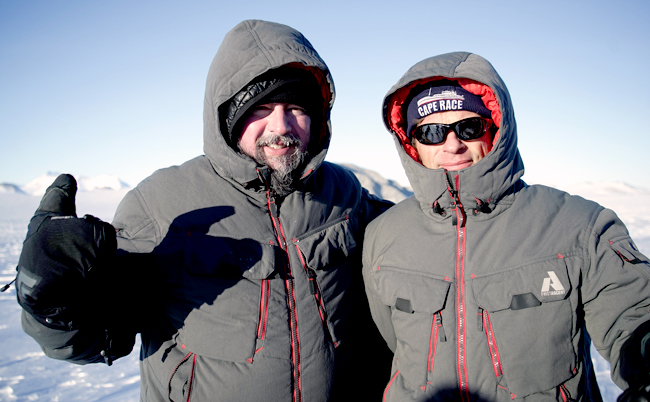Guess which: One Of these Egg Yolks Is Actually From A HEALTHY Chicken!?
One of the more interesting aspects of living in Brazil is the different approaches to food. We are connected to local farms from friends and family, spoiling us with organic homegrown everything. Regarding chicken eggs, the sizes vary, the colors of the shells vary but if the egg comes from the family farm, the yolk almost always a darker color. It is also thicker than the typical yellow yolk you find at the store.
In the United States all the eggs that can be bought at our local supermarket are yellow. Organic, vegetarian or cheap; they are all yellow and the yolk is not as thick. What is the reason for this? Could it be that myself and almost everyone I know has been eating eggs from unhealthy chickens? Have you ever even seen an orange egg? It took me 30 years to discover an egg from a healthy chicken. That’s crazy.
Having returned to the states, Craigslist is the go-to route to accommodate my urban life with homestead flare in search of the dankest foods.
From Garden Betty… Last year, I compared my pasture-foraging, insect-pecking, soil-scratching, whole grain-feeding chickens’ yolks to the yolks of both their “free-ranging” and factory-farmed counterparts. The are clearly visible: Yolks from my homegrown eggs were not only darker orange, but also fuller and thicker. Even the eggshells were denser and harder to crack. But what’s the big deal about orange yolks? Besides being a coveted color, orange yolks are an indication of a well balanced and highly nutritious diet. A few things factor into the making of an orange yolk: xanthophylls, omega-3 fatty acids, and meats. Xanthophylls are a class of carotenoids. Carotenoids are natural plant pigments found in many fruits and vegetables. It’s often thought that beta-carotene, one of the more well-known carotenoids, is responsible for giving yolks the orange pigment that people associate with carrots. But in actuality, beta-carotene benefits yolks nutritionally, rather than colorfully. The carotenoids that cause deeper yolk coloring are xanthophylls, which are more readily absorbed in the yolks. (Lutein is one such xanthophyll, and a lot of lutein means a lot more orange.) Xanthophylls are found in dark leafy greens like spinach, kale and collards, as well as in zucchini, broccoli, and brussels sprouts. Omega-3 fatty acids are highly concentrated in flax seeds and sea kelp, which are both important components of my homemade whole grain chicken feed.
And did you know that chickens are not meant to be vegetarian, no matter what your premium carton of organic/grain-fed/cage-free eggs tells you? Chickens are omnivores by nature and their healthiest diets include meats, such as mealworms, beetles, grasshoppers, grubs, and whatever creepy-crawly they can pull out of the ground. I’ve even heard of chickens (those ballsy ones out in the boonies) attacking small rodents and snakes!
When you have all of these sources incorporated into a hen’s healthful diet, the nutrients they consume are passed on to their eggs and concentrated in their yolks. According to Mother Earth News, which conducted its own egg analysis, and a more recent Pennsylvania State University study, pastured eggs contain higher levels of vitamins A, D and E; more beta-carotene; and more omega-3s.
All this means is that a pastured egg is better for you. And that’s one of the reasons we raise chickens, right?
So, how do we get those delightful dark orange yolks from our backyard chickens?
Let your ladies roam a pasture (or a garden – especially if you’re digging over new beds – or even just a new patch of dirt in their chicken tractor) for an orange-boosting bug buffet.
Give them plenty of fresh greens to increase the lutein in their yolks. The darker the green the better, so I often fix them a feast of edible amaranth (one of my favorite summer greens), kale, collards, broccoli leaves, or whatever I happen to have growing in my garden. If it’s the middle of winter and your garden greens are lacking, you can feed them alfalfa.
They’re very handy helpers at the end of the season when most of my greens have bolted and become bug-ridden. Let the chickens clean up those plants before you pull them out for your compost pile. It’s a win for everybody! (Except the bugs, that is…)

(As an aside, don’t be fooled by the cheater method that egg factories take, and simply feed your chickens more corn. While corn can give your yolks that nice golden color, it has little nutritional value.)
After a few weeks, you’ll be so used to seeing orange yolks (the way most of us have been conditioned to see yellow yolks) that you might even think they haven’t changed in color. Buy some eggs from the store and crack them into a bowl with your homegrown eggs – you’ll be stunned at the difference!
Those are some interesting observations by Garden Betty. Here is a bit more of an explanation by food and nutrition.
When it comes to yolks, the color is determined by a hen’s diet, not its breed (artificial color additives are not permitted in eggs) or the freshness of the egg. Hen diets heavy in green plants, yellow corn, alfalfa and other plant material with xanthophylls pigment (a yellow-orange hue) will produce a darker yellow-orange yolk. Diets of wheat or barley produce pale yellow yolks; hens fed white cornmeal produce almost colorless yolks.
Free-range hens may have access to more heavily pigmented food so they may produce eggs with darker yolks. According to the American Egg Board, consumer preference in the U.S. is typically for light gold- or lemon-colored yolks.
At the end of the day, know your farmer and the diet of the chickens producing the eggs to be eaten.
Comments
comments
World Faces Severe Water Shortage If Changes Are Not Made, UN Warns | VICE News
With the world’s population expected to grow to 9.1 billion by mid-century, already depleted groundwater supplies will continue to be gobbled up by agriculture, industry, power generation and personal use, according to the UN’s annual World Water Development Report.
The report, released Friday, says that around 20 percent of groundwater sources are already “overexploited” – a problem that will only grow more dire by 2050, when demand for water is expected to have risen by more than half.
Most alarmingly, the report warns that as early as 2030, the planet could have only 60 percent of the water required to sustain itself if substantial changes are not made to improve management of the resource.
“Unless the balance between demand and finite supplies is restored, the world will face an increasingly severe global water deficit,” says the report.
“Unless the balance between demand and finite supplies is restored, the world will face an increasingly severe global water deficit.”
Richard Connor, lead author of the UN report and an independent water expert, told VICE News that the crisis could possibly be averted if countries mandate efficient water use and attach a greater price to water itself. He said climate change, which is already beginning to exacerbate variations in weather patterns – some parched climates may become even drier in the future, wetter ones rainier – makes that task even more pressing.
“With respect to climate change, the two major problems have to do with salt water intrusion in aquifers due to sea level rise, as well as the impact in the variability of distribution of rain,” Connor said.
Coastal cities like Kolkata, Shanghai, Dhaka and Jakarta already face a rise in salinization of their fresh water supplies in part due to uncontrolled groundwater extraction. As salt water mixes with longstanding aquifers, both licit and illegal wells are dug deeper, furthering the problem.
In Dhaka, the capital of Bangladesh and one of the most vulnerable cities to sea rise, the World Bank predicts salt content in soil could decrease the yields of some rice crops by more than 15 percent. By 2050 researchers say climate change will cause the salinity of rivers in Bangladesh to vary significantly during dry seasons and lead to the disruption of important aquatic habitats for animals like freshwater fish and prawns. Even road construction will cost more, as higher salt levels in soil cause cracking in paved surfaces.
Related: Despite the Deep Freeze on the US East Coast, This Winter Was the Hottest on Record
Connor said that inefficient water consumption is irreplaceably draining water supplies in places like the Western US, Middle East and in parts of North Africa, China, and small island states in the Pacific.
“In all of these places people rely on ground water for irrigation and other uses.” he said. “And in a lot of cases the ground water isn’t used sustainably, they are basically just taking money out of the bank,” added Connor.
The report highlighted several localized cases where governments were able to better manage supplies. In Cyprus, subsidies and low-interest loans for farmers helped many switch to more efficient irrigation systems. That efficiency, however, may only “lead to the expansion of irrigated areas instead of increased flows in rivers,” it warned.
“In a lot of cases the ground water isn’t used sustainably, they are basically just taking money out of the bank.”
The report arrives as UN officials are coming to grips with the devastation Cyclone Pam last week inflicted on the Pacific island nation of Vanuatu. Scientists say climate change will only worsen the intensity of storms like Pam and Typhoon Haiyan, which made landfall in the Philippines in 2013 with record strength, leaving more than 6,000 people dead. Such storms already are disrupting delicate water supplies in vulnerable areas.
At the opposite extreme, record droughts are hitting places like the Western United States and Brazil, and imperiling agriculture in those areas.
Although industry, power generation and personal use of water loom large in many parts of the world, agricultural activities account for around 70 percent of water use globally, and as much as 90 percent in poorer countries. The UN predicts the sector will need to produce 60 percent more food to feed the world’s population by 2050, and it is not clear where the requisite water for such a surge in food production will come from.
“California is in particular in trouble, which means the US is in trouble, because California is where a lot of the US’s food is produced,” said Connor, who predicted American food prices will rise in the coming years.
Related: Watch A Weeks’ Worth of Senator Ted Cruz Denying Climate Change
The report, which was unveiled in Delhi, called on countries to raise their water tariffs, claiming they were currently “far too low to actually limit excessive water use by wealthy households or industries.”
Governments in developing countries face the daunting goal of decreasing or altering use while at the same time extending proper sanitation systems and clean supplies of fresh water to impoverished communities. In India, where more than half a million people still defecate in the open, some 748 million people also remain without permanent access to an improved drinking water source.
Related: Follow Samuel Oakford on Twitter: @samueloakford
It Might Be Possible To Reduce Carbon Emissions And Grow The Economy At The Same Time
Connor points to UN estimates that put the return on every dollar spent on sanitation at more than five times the initial investment – a payoff seen in decreased healthcare costs due to lessened disease transmission and a subsequent rise in worker productivity. But upfront costs for sanitation systems can be expensive, and in many cases more wells are simply dug.
“If we continue business as usual we are on an unsustainable path,” said Connor.
Are Insects the Next Climate-Friendly Superfood?
Maybe you’ve see little cans of chocolate-covered ants or grasshoppers in the exotic food section of your grocery and thought to yourself, “Yuck-who eats that?” Insects may not come to mind when you think of superfoods. But they could be the next hot “alternative” protein. They’re low in fat and loaded with fiber.
You might be surprised to learn you may have been eating insects already. More than 30 companies are already using cricket flour in their products such as cookies and energy bars. And while eating insects is common in Latin America, southeast Asia and parts of Africa because they’re a cheaply available commodity, in the U.S. food items containing cricket flour, which is still expensive to produce, are being marketed as artisan products intended for adventurous foodies eager to try something before everyone else.
“Demand for food-grade insects is growing rapidly,” says the website for Tiny Farms, a Silicon Valley-based start-up “pioneering the industry production of insects.”
Currently, it admits, edible insects are a niche products with the cost of a pound of cricket flour ranging from $25-$45. But it says that’s due to lack of scale and it hopes to change that.
“Right now in February 2015,” said a recent post on the Tiny Farms blog “there are dozens of restaurants around the country experimenting with insects on their menus-from culinary hubs like San Francisco, Los Angeles and New York City to more conservatively palated Austin, Texas and Youngstown, Ohio. Food startups Exo, Chapul, Hopper Foods and Bitty Foods are ramping up production of their cricket flour energy bars and baked goods and growing their brick-and-mortar distribution networks in addition to serving up online sales. Exo’s bars are even slated to be included in a snack box served on JetBlue Airlines flights. Boston-based Six Foods is preparing to launch their cricket chips, and dozens more new companies are developing products, business plans and marketing strategies to serve edible insects to the Western masses.”
Youngstown, Ohio is mostly known for the death of its once-prosperous steel industry, which shrunk the city from 170,000 people to 65,000. But maybe it will become the edible insect capitol of the U.S. Big Cricket Farms, a project mentored by Tiny Farms, bills itself as “America’s first urban cricket farm.” Launched just last year, it says it’s “devoted exclusively to raising human-grade entomophagical products” and that its crickets are fed high-quality, organic, sustainable feed. Founder Kevin Bachhuber first got the idea when he found himself snacking on bugs during a trip to Thailand and “found them to be delicious.”
“So I raise bugs and I feed them to people,” said Bachhuber in a recent TEDxYoungstown talk. “I’m shocked at how popular this has proven to be.”
The farm raises European House Crickets, which it says “are considered to be tastiest, and are thus the most popular. They also offer a better nutritional profile than some of the other cricket species that humans typically consume.”
The Washington Post referred to crickets as a “gateway bug” in an article titled How crickets could hook America on eating insects. What could they lead to? “Keep an eye on meal worms, fly larvae, caterpillars, black soldier flies and wax worms,” says the Post.
England’s Edible Unique, which serves the high-end gourmet market with edible bugs, offers such delicacies as chocolate-dipped crickets, bug kabobs, “extra large ‘n’ crunchy” Thai scorpions, bamboo worm larvae, edible giant water bugs and a mixture of Weaver ant eggs and Chinese black ants advertised as particularly “high in protein.” They’re sold out of insect lollipops so a lot of kids must have gotten a special treats.

With agriculture accounting for more than 8 percent of U.S. greenhouse gases, there’s a great environmental benefit in going to insects as a source of protein. They require 1/12 as much feed as cattle, 1/4 as much feed as sheep and half as much feed as pigs and broiler chickens for the same amount of protein as well as a fraction as much water per gram of protein as all of these. And 80 percent of a cricket is edible, compared to 40 percent of a cow. A 2013 report released by the UN Food and Agricultural Organization (FAO), Edible Insects: Future prospects for food and feed security, focused on using insects as viable solution for feeding the world’s growing population in a planet-friendly way as well as an engine for economic development.
“Insects as food and feed emerge as an especially relevant issue in the twenty-first century due to the rising cost of animal protein, food and feed insecurity, environmental pressures, population growth and increasing demand for protein among the middle classes,” it says. “Edible insects have always been a part of human diets, but in some societies there is a degree of distaste for their consumption. Although the majority of edible insects are gathered from forest habitats, innovation in mass-rearing systems has begun in many countries. Insects offer a significant opportunity to merge traditional knowledge and modern science in both developed and developing countries.”
So what kinds of insects are being consumed for the approximately 2 billion people worldwide who don’t live in societies with that “degree of distaste?” Beetles lead the list by a large margin, followed by caterpillars, bees, wasps, ants, crickets, grasshoppers and locusts.
Even earthworms are edible, according to Mother Earth News, which gives instructions on how to get the dirt they consume out of their bodies and says, “After purging, their flavor can be a little bitter. Drying them mellows this flavor; incorporating them into various dishes helps as well. They can be added to stirfries, stews, anywhere your imagination wanders.”
One big debate remains: can or should vegetarians eat insects? Opinions vary.
YOU MIGHT ALSO LIKE
Can Insects Feed a Hungry Planet?
This Water Faucet Saves Water By Creating Beautiful Spirals
Simin Qiu, a student at London’s Royal College of Art, has invented a unique water faucet that uses the laws of physics to save water.
Qiu was inspired by the many sacred spirals that exist in nature, in plants, shells and many other examples of natural spiraling phenomena. Qiu also noticed that water spiraled in nature in many circumstances, especially when in a pipeline.
Researching further, Qiu found that water actually slows down while in a spiral or pipeline, so he set out to create a water faucet that would create a spiral, and hopefully save water.
This goal led Qiu to design a water facet called “Swirl”, which sends the water from the faucet in a pipeline, and allegedly saves up to 15% on water usage! Qiu then created three different designs which will each save money on your water bill, although every faucet has a unique pattern.
Qiu’s Swirl design won an iF Design concept award in 2014, and he hopes to be able to distribute the faucet on a mass scale in the near future.
John Vibes writes for True Activist and is an author, researcher and investigative journalist who takes a special interest in the counter culture and the drug war. .
Throw Out Your Toothpaste – Coconut Oil Works Better Than Any Commercial Toothpaste
Toothpaste is one of those things that everyone buys, but did you know that standard toothpaste produced commercially is loaded with nasty chemicals? They contain things like Sodium Laurel Sulfate, which exacerbates canker sores, and triclosan, which is similar to BPA in that it causes hormonal disruption.
Hell, just look at the stuff. Why on Earth would you need to put sparkly blue fluorescent paste in your mouth? Fortunately there is an alternative.
Coconut oil is a powerful plant extract that is capable of killing bacteria responsible for oral decay. Irish scientists found that coconut oil is able to kill steptococcus mutans, which is the bacteria that causes dental erosion. It’s also able to kill Candida albicans.
So how should coconut oil be used as a toothpaste? You can use straight coconut oil or try this recipe.
You will need:
- 6 tablespoons of coconut oil
- 6 tablespoons of baking soda
- 25 drops of essential oil (if you prefer a flavor)
- 1 tsp of stevia (only if you want it to be sweeter)
Instructions:
- Mix ingredients in a bowl and whip until it’s a light, creamy texture.
- Pour into a mason jar. Leave the lid on between uses.
There you go! Have you tried this recipe before? Let us know what you think.
Obama Signs Executive Order Cutting Federal Government Carbon Emissions
CREDIT: Dennis Schroeder, NREL
On Thursday morning, President Obama signed a new executive order that requires the federal government to cut greenhouse gas emissions by 40 percent by 2025 from 2008 levels. A fact sheet distributed by the White House noted that this could boost government renewable energy sources to 30 percent, and save taxpayers $18 billion in energy costs.
Calling this action a “triple win: a win for environment, a for the economy, and for the American taxpayer,” White House Senior Advisor Brian Deese told reporters that this executive order will “raise the bar” beyond previous actions the President has taken to confront climate change head-on.
One reason is that it’s not just federal agencies that will commit to cutting carbon pollution. Several major federal suppliers, such as Lockheed Martin, General Electric, and IBM announced new voluntary commitments to cut their own emissions as well. With suppliers and agencies jointly shrinking their carbon footprints, the White House estimates that greenhouse gas emissions will drop by 26 million metric tons – 5 million from the private sector, 21 million from the public sector. In total, this is the equivalent of taking 5.5 million cars off the road for a year.
A new scorecard will allow citizens to keep track of how individual suppliers are doing on greenhouse gas management.

CREDIT: whitehouse.gov
Deese said these were new, “very ambitious goals,” beyond what the companies would do normally. He noted that IBM, for example was committed to cutting energy-related greenhouse gas emissions 35 percent by the end of the decade against 2005 levels.
He said the administration was “very confident” that this progress would continue past the end of the President’s term because these goals make financial sense for the agencies that will be implementing them.
When Obama rolled out his Climate Action Plan in 2013, he noted that the federal agencies had already cut their emissions by 15 percent since 2009, and pledged to have the government powered by 20 percent renewable sources by 2020.
In 2009, the President signed an executive order that directed agencies to “increase energy efficiency” as well as “measure, report, and reduce their greenhouse gas emissions from direct and indirect activities.”
A year later, he set the goal more specifically: a 28 percent cut in direct greenhouse gas emissions by 2020, and a 13 percent drop in indirect emissions. The White House estimated that doing this through a combination of energy efficiency, cutting petroleum usage, and boosting renewables would avoid between $8 and $11 billion in energy costs.
The Pentagon has been pursuing a smaller energy footprint for years, as it saves money and saves lives. Operationally, some of the worst threats are attacks on convoys bringing fuel to forward operating bases. If those bases can stop relying on a loud diesel generator in lieu of a quiet renewable power source, it can help protect lives. When domestic bases consume less energy through efficiency, EVs, and renewable power, there is more room in the budget for other priorities.
It’s starting to work. In Fiscal Year 2013, the Defense Department’s total energy use had fallen to its lowest level on record (records began in 1975). DoD’s energy consumption is massive even on a global scale, with nearly 300,000 buildings on 500 installations across the globe. The EIA, which reported the data, noted the drawdown in Iraq and Afghanistan as one cause. It also highlighted lower government building energy use since the 2007 energy bill set initial goals – energy intensity had dropped 17 percent in FY 2013 compared to 2003.
Outdoor LED lights could save the U.S. more than $6 billion per year, by using 80 percent less energy than the incandescents they would replace.
The Department of Energy has conducted several gateway demonstration projects in museums to see if LED lights could handle environments that demand high-quality lighting. For the most part they did, with thousands of dollars in energy savings in one demonstration gallery at the Smithsonian American Art Museum alone, earning back the investment within 18 months.
One blind spot in federal carbon emissions, however, is taxpayer-owned oil, gas, and coal extracted from public lands. According to a new report from the Center for American Progress, emissions from federal lands and waters could have accounted for nearly a quarter of the country’s total energy-related emissions in 2012. The real number may never be known, however, because the Interior Department, which is in charge, does not have a comprehensive plan to measure and cut emissions from public lands energy extraction.
Canada’s Largest Food Retailer To Sell Ugly Produce At Low Prices To Cut Food Waste
CREDIT: Niloo / Shutterstock.com
Shoppers in Canada will have to look beyond appearance if they want to help reduce food waste – and save some money along the way.
Loblaws, the country’s largest food retailer, launched a campaign last week to sell misshapen, “ugly” produce at a discounted rate in an effort to curb the country’s food waste problem (annually, Canadians waste some 40 percent of their food).
The campaign, called No Name Naturally Imperfect, offers aesthetically displeasing apples and potatoes at a discount of up to 30 cents in select Loblaws-owned stores in Ontario and Quebec. “We often focus too much on the look of produce rather than the taste,” said Ian Gordon, senior vice president, Loblaw Brands, Loblaw Companies Limited, in a press statement. “Once you peel or cut an apple you can’t tell it once had a blemish or was misshapen.”

CREDIT: Loblaws
According to the U.N. Environment Program, between 20 and 40 percent of produce is thrown away by farmers simply because it isn’t pretty enough for grocery store shelves. The produce being sold under Loblaws’ new campaign would have been used for juices or soups, or might not have been harvested at all, due to their appearance. Though the campaign is beginning with apples and potatoes, company officials hope that the program will serve as a springboard for the sale of other ugly fruits and vegetables in the future.
The move offers savings to both the consumer, who can access healthy produce at lower costs, and the Canadian government, which loses some $31 billion dollars annually on food waste. Globally, food waste costs nearly $400 billion annually, but according to a February report released by the U.K.-based Waste & Resources Action Program (WRAP), countries could save between $120 and $300 each year by focusing on reducing food waste.
In developed nations, food waste happens most often at the retail and consumer level. Grocery stores often adhere to strict quality guidelines that place too much emphasis on appearance, leading to the disposal of produce that is nutritionally sound but not aesthetically pleasing. Each year, enough unspoiled food is thrown away in developed nations to feed the world’s 870 million hungry people.

CREDIT: Shutterstock
But food waste is more than an economic burden – it’s increasingly becoming an environmental burden as well. Most food waste ends up in landfills, where it decomposes and releases methane, a greenhouse gas nearly 30 times more potent than carbon dioxide. In the U.S., where nearly 30 percent of food is wasted, organic waste is the second most prevalent element in landfills. Globally, food waste accounts for 7 percent of greenhouse gas emissions. If food waste were a country, it would be the third largest producer of greenhouse gases, eclipsed only by the United States and China.
Loblaws isn’t the first retailer to decide that the industry’s insane standards of beauty are a detriment to their bottom line and the environment. In 2014, the E.U. launched the European Year Against Food Waste, prompting French supermarket Intermarché to sell disfigured fruits and vegetables for a lower price than their conformist counterparts. The campaign, titled ” Inglorious Fruits and Vegetables,” created a 24 percent uptick in store traffic, reaching 21 million customers in its first month alone.
As greenhouse gas emissions increase – driven by food waste and countless other factors – consumers might be forced to be less picky eaters anyway. A new report published by climate scientists at the University of Melbourne warns that the effects of climate change, including shifting rainfall patterns and climate-related diseases, will result in the production of less flavorful, lower-quality food. Apples, for instance, are sensitive to heat, and can be affected by as little as 10 minutes of extreme sunlight. If mealy, sunburned apples don’t sound like an appealing future food, maybe buying a small, knobby apple now isn’t such a bad alternative.
NOAA: Hottest Winter On Record Globally, 19th-Warmest Winter In U.S.
If you live on the East Coast of the United States, the National Oceanic and Atmospheric Administration has just released some statistics that may surprise you:
- Globally, this has been the hottest winter on record, topping the previous record (2007) by 0.05°F.
- This was “the 19th warmest winter for the contiguous US.”
- Globally it’s easily been the hottest start to any year (January-February), beating the previous records (2002, 2007) by 0.07°F.
- This was the second warmest February globally, and “slightly below” the 20th-century average in the contiguous U.S.
- Note: For NOAA, winter is the “meteorological winter” (December 2014 to February 2015).
As the NOAA map above shows, other than the “cooler than average” northeast, this winter has been “warmer than average” and “much warmer than average” and “record warmest” over every other land area in the world.
In particular, many Western states saw their hottest winter on record – which is not a surprise if you live in drought-stricken California or its neighbors:

Now entering its fourth year, the drought in California is so bad that NASA senior water scientist Jay Famiglietti warned that “the state has only about one year of water supply left in its reservoirs, and our strategic backup supply, groundwater, is rapidly disappearing.” Global warming-driven record heat has made this the worst California drought in 1200 years, as scientists explained in December.
The Earth keeps setting the record for the hottest 12 months in the surface temperature record, as we reported Saturday. NOAA’s global data show we’ve started this year at a record pace – and early indications are that March will be warm globally – so we are on track for what is likely to be the hottest calendar year on record.
Tesla’s Ultra-Speed Hyperloop Transportation System Will Change Transportation As We Know It
Elon Musk is at it again. Next year the construction of an innovative, ultra-speed transportation system called Hyperloop will commence in central California. It is the world’s first supersonic overland transport system, with the ability to reach speeds up to 800 mph.
Like most other Musk-inspired creations, the Hyperloop conceptseems like something straight out of the future.
” We feel now that we’re at a stage where questions are answered on a theoretical level so now we’re moving on to prototyping,” Dirk Ahlborn, CEO of Hyperloop Transportation Technologies (HTT), told IBTimes UK.
To begin, the first 5-mile stretch Hyperloop system will begin construction in 2016 in a brand-new sustainable community called Quay Valley, located between Los Angeles and San Francisco.
” This five-mile stretch will allow us to completely test the technology, from the boarding process to the safety procedures – really everything except top speed,” Ahlborn said.

Musk’s vision sees the Hyperloop as a 400-mile long network of above-ground tubes with very low air pressure inside them, which allows bus-sized capsules to travel through those tubes at near supersonic speeds (approaching 800 mph).
When built, the full-scale version of the vacuum transportation network will take passengers and freight at speeds of up to 760mph. The system is being deemed as a 1000% improvement on today’s transport.
” We will move people and cargo at speeds never thought possible. We will make the world smaller, cleaner and more efficient,” states HTT on their official website.
Beyond the US, dozens of other countries have expressed an interest in Hyperloop, including China and the United Arab Emirates. For Ahlborn, these countries offer the most hope for full-scale systems being implemented because, “if they decide to build something like Hyperloop, they just build it.”
Almost 200 engineers from NASA, Yahoo!, and Airbus are involved in the project realization. There is also a group of 25 students from University of California (UCLA) working on different issues including cost estimation, route planning, and capsule design.

This proposed transportation system is extraordinary, with a glowing potential to change the way the world commutes as we know it. Someone in New York could simply hop on and be in Miami in under 2 hours, or Los Angeles in just over 3 hours. Not to mention how much more affordable this type of transportation will likely be compared to flying. We are so excited about this! Stay tuned for more updates on the Hyperloop as things progress.
What are your thoughts on this new transportation concept? Share with us in the comment section below!
Free Happiness Training!
Do you want to bring more happiness into your life?
Happify’s activities and games are based on a decade’s worth of cutting-edge research by psychologists and neuroscientists from leading academic institutions around the world.
Happify’s exercises are personalized directly for you based on your unique goals.
If you are looking to bring more peace and joy into your life this year Start out with Happify for FREE!
The melting of Antarctica was already really bad. It just got worse.
A hundred years from now, humans may remember 2014 as the year when we first learned that we may have irreversibly destabilized the great ice sheet of West Antarctica, and thus set in motion more than 10 feet of sea level rise.
2015, meanwhile, could be the year of the double whammy – when we learned the same about one gigantic glacier of East Antarctica, which could set in motion roughly the same amount all over again. Northern hemisphere residents and Americans in particular should take note – when the bottom of the world loses vast amounts of ice, those of us living closer to its top get more sea level rise than the rest of the planet, thanks to the law of gravity.
The findings about East Antarctica emerge from a new paper just out in Nature Geoscience by an international team of scientists representing the U.S., Britain, France and Australia. They flew a number of research flights over the Totten Glacier of East Antarctica – the fastest-thinning sector of the world’s largest ice sheet – and took a variety of measurements to try to figure out the reasons behind its retreat. And the news wasn’t good: It appears that Totten, too, is losing ice because warm ocean water is getting underneath it.
[Related: Research casts alarming light on the decline of West Antarctic glaciers]
“The idea of warm ocean water eroding the ice in West Antarctica, what we’re finding is that may well be applicable in East Antarctica as well,” says Martin Siegert, a co-author of the study and who is based at the Grantham Institute at Imperial College London.
The Totten Glacier covers an area of 40 miles by 18 miles. It it is losing an amount of ice “equivalent to 100 times the volume of Sydney Harbour every year,” notes the Australian Antarctic Division.
That’s alarming, because the glacier holds back a much more vast catchment of ice that, were its vulnerable parts to flow into the ocean, could produce a sea level rise of 3.5 meters, or more than 11 feet – which is comparable to the impact from a loss of the West Antarctica ice sheet. And that’s “a conservative lower limit,” says lead study author Jamin Greenbaum, a PhD candidate at the University of Texas, Austin.
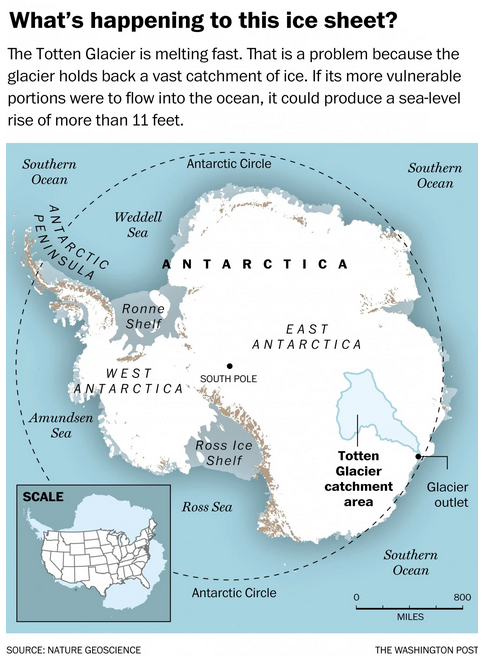
In its alignment with the land and the sea, the Totten Glacier is similar to the West Antarctic glaciers, which also feature so-called ice shelves that slope out from the vast sheet of ice on land and extend into the water. These ice shelves are a key source of instability, because if ocean waters beneath them warm, they can lose ice rapidly, allowing the ice sheet behind them to flow more quickly into the sea.
The researchers used three separate types of measurements taken during their flights – gravitational measurements, radar, and laser altimetry – to get a glimpse of what might be happening beneath the massive glacier, whose ice shelves are over 500 meters thick in places. Using radar, they could measure the ice’s thickness. Meanwhile, by measuring the pull of the Earth’s gravity on the airplane in different places, the scientists were able to determine just how far below that ice the seafloor was.
The result was the discovery of two undersea troughs or valleys beneath the ice shelf – regions where the seafloor slopes downward, allowing a greater depth of water beneath the floating ice. These cavities or subsea valleys, the researchers suggest, may explain the glacier’s retreat – they could allow warmer deep waters to get underneath the ice shelf, accelerating its melting.

In this particular area of Antarctica, explains Greenbaum, a warmer layer of ocean water offshore is actually deeper than the colder layers above it, due to the saltwater content of the warm water (which increases its density). And the canyons may allow that warm water access to the glacier base. “What we found here is that there are seafloor valleys deeper than the depth of the maximum temperature measured near the glacier,” says Greenbaum.
One of these canyons is three miles wide, in a region that was previously believed to simply hold ice lying atop solid earth. On the contrary, the new study suggests the ice is instead afloat.
The availiability of warm water, and the observed melting, notes the study, “support the idea that the behaviour of Totten Glacier is an East Antarctic analogue to ocean-driven retreat underway in the West Antarctic Ice Sheet (WAIS). The global sea level potential of 3.5 m flowing through Totten Glacier alone is of similar magnitude to the entire probable contribution of the WAIS.”
One limitation of the study is that the scientists were not able to directly measure the temperature of ocean water that is reaching the glacier itself. While this could be done with robotic underwater vehicles or other methods, that wasn’t part of the study at this time. Thus, the conclusions are more focused on inferring the vulnerability of the glacier based on a number of different pieces of evidence – topped off by the fact that the glacier is, indeed, retreating.
[Related: These subsea drones are figuring out just how badly we are messing up the planet]
For residents of the United States – and indeed, the entire northern hemisphere – the impact could be more dire. If Antarctica loses volumes of ice that would translate into major contributions to sea level rise,that risewould not be distributed evenly around the globe. The reason is the force of gravity. Antarctica is so massive that it pulls the ocean towards it, but if it loses ice that gravitational pull will relax, and the ocean will slosh back towards the northern hemisphere – which will experience additional sea level rise.
For the United States, the amount of sea level rise could be 25 percent or more than the global average.
Much as with the ocean-abutting glaciers of West Antarctica, just because a retreat has been observed – and because the entirety of the region implies a sea level rise of 11 or more feet were all ice to end up in the ocean – does not mean that we’ll see anything near that much sea level rise in our own lifetimes. These processes are generally expected to play out over hundreds of years or more. They would reshape the face of the Earth – but we may never see it.
The problem, then, is more the world we’re leaving to our children and grandchildren – because once such a gigantic geophysical process begins, it’s hard to see how it comes to a halt. “With warming oceans, it’s difficult to see how a process that starts now would be reversed, or reversible, in a warming world,” says Siegert.
WATCH HBO’s Award-Winning VICE Exposes Climate Deniers and the Dire Consequences of Sea Level Rise
The first episode covers the pressing issue of sea level rise. VICE Media founder Shane Smith travels to the bottom of the world to investigate the instability of the West Antarctic ice sheet and see how the continent is melting. Then, the VICE crew heads to Bangladesh to capture the impacts of rising sea levels on this South Asian country.
“From the UN Climate conference to the People’s Climate March to the forces that deny the science of global climate change,” says HBO, “this extended report covers all sides of the issue and all corners of the globe, ending in a special interview with Vice President Joe Biden.”
VICE is an innovative media company whose correspondents cover stories that traditional news outlets often overlook. HBO partners with VICE to produce the weekly series. And the season premiere has good timing because next week Robert Swan will take his 2041 team on this year’s International Antarctic Expedition to show the firsthand effects of climate change on the continent.

“If even a small fraction of the ice sheet in Antarctica melts, the resulting sea level rise will completely remap the world as we know it,” says VICE Media founder Shane Smith.
“Antarctica holds 90 percent of the world’s ice and 70 percent of its freshwater,” says VICE Media founder Shane Smith. “So if even a small fraction of the ice sheet in Antarctica melts, the resulting sea level rise will completely remap the world as we know it. And it is already happening: In the last decade, some of the most significant glaciers [in Antarctica] have tripled their melt rate.”
Antarctica is getting all of this attention because if “it starts melting at the same rate as Greenland, we’re in for trouble,” says Smith. And yet, “in the face of overwhelming scientific evidence,” says Smith, there’s a small, but vocal group of climate deniers that have skewed public perception of climate science and stonewalled efforts to take meaningful action in addressing climate change.
VICE gets an inside look at these self-proclaimed “skeptics” at their annual International Conference on Climate Change hosted by the Heartland Institute, who are funded by the likes of Exxon Mobil and the Koch Brothers. As Upton Sinclair famously said, “It is difficult to get a man to understand something when his salary depends upon his not understanding it.”
Record First: Global CO2 Emissions Went Flat In 2014 While The Economy Grew
CREDIT: Shutterstock
Energy-related carbon dioxide emissions flatlined globally in 2014, while the world economy grew. The International Energy Agency reports that this marks “the first time in 40 years in which there was a halt or reduction in emissions of the greenhouse gas that was not tied to an economic downturn.”
The IEA attributes this remarkable occurrence to “changing patterns of energy consumption in China and OECD countries.” As we reported last month, China cut its coal consumption 2.9 percent in 2014, the first drop this century. China is aggressively embracing energy efficiency, expanding clean energy, and shuttering the dirtiest power plants to meet its planned 2020 (or sooner) peak in coal use. As a result, Chinese CO2 emissions dropped 1 percent in 2014 even as their economy grew by 7.4 percent.
At the same time, the Financial Times points out “In the past five years, OECD countries’ economies grew nearly 7 percent while their emissions fell 4 percent, the IEA has found.” A big part of that is the United States, where fuel economy standards have reversed oil consumption trends – and renewable energy, efficiency, and natural gas have cut U.S. coal consumption.
All this “provides much-needed momentum to negotiators preparing to forge a global climate deal in Paris in December,” explained IEA Chief Economist Fatih Birol, who was just named the next IEA Executive Director. “For the first time, greenhouse gas emissions are decoupling from economic growth.”

CREDIT: IEA, Financial Times
The IEA notes that in 40 years of CO2 data collection, the three previous times emissions have flatlined or dropped from the prior year “all were associated with global economic weakness: the early 1980’s [due to the oil shock and U.S. recession]; 1992 and 2009.”
Remember the pre-Paris pledges we already have: China to peak in CO2 emission by 2030 (or, likely, sooner), EU to cut total emissions 40 percent below 1990 levels by 2030, and U.S. “to cut net greenhouse gas emissions 26-28 percent below 2005 levels by 2025.” That means there is a very real prospect for a game-changing global deal coming out of Paris this year.
Such a deal would not will “not get us onto the 2°C pathway,” as Christiana Figueres, the top UN climate official, and others have explained. But it would get us off the catastrophic 6°C path and lead to a permanent decoupling of GDP and CO2.
And that would give the next generation a realistic chance at coming close to a 2°C path in the 2020s and 2030s. That’s when stronger action will become more viable as it becomes harder to deny the painful reality of just how dire our situation is – and as the sped-up deployment of clean energy required for countries to meet Paris commitments make achieving 2°C even more super-cheap.




